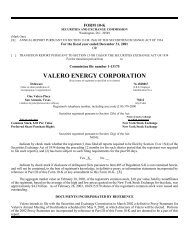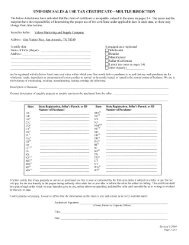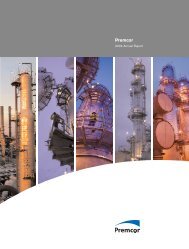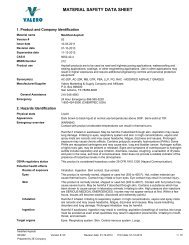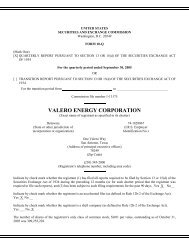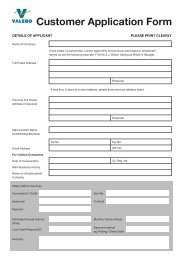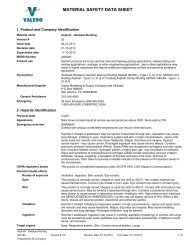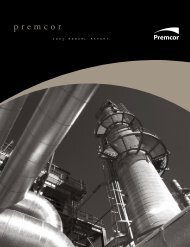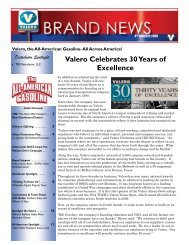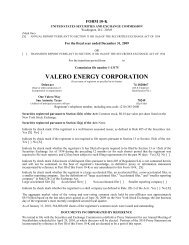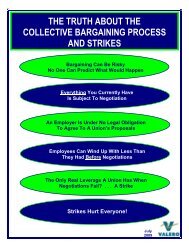Excellence Refined - 30 Years - Valero
Excellence Refined - 30 Years - Valero
Excellence Refined - 30 Years - Valero
Create successful ePaper yourself
Turn your PDF publications into a flip-book with our unique Google optimized e-Paper software.
As a former UDS executive, <strong>Valero</strong> CEO Bill Klesse still<br />
recalls the diversity and sheer size of the acquisition<br />
in 2001. “The UDS deal gave <strong>Valero</strong> the size it needed<br />
to take on more risk going forward,” said Klesse,<br />
who became CEO in 2006. “It gave <strong>Valero</strong> a lot more<br />
mass, and with that, the ability and the opportunity<br />
to invest in places like St. Charles and Aruba.”<br />
The deal also gave <strong>Valero</strong> entry into sweet crude<br />
refining, and into new business territories in Canada.<br />
With the close of 2001, <strong>Valero</strong> was indeed a whole new<br />
company. Purpose-driven growth was its guidepost, now<br />
even more attainable with the financial stability created<br />
by UDS. The addition meant even more employees<br />
and instant ownership of 1,000 retail stores and 3,000<br />
branded outlets. Through it all, <strong>Valero</strong> continued to<br />
focus on sour crude refining and capture the benefits of<br />
diversification. While the refineries would provide synergy<br />
and bigger geographic punch to <strong>Valero</strong>’s presence in<br />
North America, the new retail arm gave the company<br />
something refining could not: a face to the general public.<br />
UDS’ Diamond Shamrock brand had been around since<br />
the 1970s and was a fixture in certain parts of the country<br />
– particularly its headquarters state of Texas. Before that,<br />
Ultramar stores in Eastern Canada had been in operation<br />
since the 1960s. And even earlier, Diamond Shamrock’s<br />
predecessors, including the original Shamrock brand,<br />
had operated successfully since the 19<strong>30</strong>s. The entire<br />
system had been supported by the UDS Credit Service<br />
Center in Amarillo, Texas, which to this day serves credit<br />
card customers each year. By 2002, <strong>Valero</strong> had improved<br />
the profitability of its retail division by investing in topperforming<br />
sites, including remodeling or even rebuilding<br />
stores, acquiring new sites and closing marginal sites.<br />
As a side venture, <strong>Valero</strong> also began to grow a branded<br />
wholesale business that began with the Exxon purchase<br />
in 2000 but grew with the UDS acquisition in 2001. In the<br />
wholesale market, <strong>Valero</strong> could build brand recognition<br />
and customer loyalty through independent operations,<br />
without the high cost of operating and staffing its own<br />
stores. These “jobbers,” as they are known, offered <strong>Valero</strong><br />
credit cards and had access to advertising and promotions<br />
but were independently owned and operated. In August<br />
2006, <strong>Valero</strong> announced an 11-year agreement with<br />
Susser Petroleum – the largest single-branded wholesale<br />
deal in <strong>Valero</strong> history in fuel volumes and number of<br />
sites – to supply fuel and brand programs to more than<br />
<strong>30</strong>0 of Susser’s network of 324 retail stores in Texas and<br />
Oklahoma. <strong>Valero</strong> also began branding selected sites<br />
from Susser’s network of 352 wholesale dealers – thus<br />
becoming Texas’ No. 1 rack fuel marketer with 1,900<br />
branded wholesale and company-owned locations, and<br />
significant unbranded sales volumes around the state.<br />
By 2007, <strong>Valero</strong> had earned Convenience Store Chain of<br />
the Year by Convenience Store Magazine and was actively<br />
looking to grow its jobber network. It was clear <strong>Valero</strong><br />
needed a strong national image to hook consumers and<br />
investors. So on June <strong>30</strong>, 2005, on the eve of one of the<br />
busiest driving holidays of the year, <strong>Valero</strong> announced<br />
its most ambitious retail plans yet – transform its entire<br />
U.S. network to the <strong>Valero</strong> brand, converting Diamond<br />
Shamrock stores to <strong>Valero</strong>’s signature teal and gold.<br />
A plot of land alongside Interstate 37 in Corpus Christi,<br />
Texas – within view of <strong>Valero</strong>’s flagship refinery – gave<br />
birth to the first company-owned, branded <strong>Valero</strong> site<br />
outside of California. By the end of 2009, the company<br />
operated 1,000 <strong>Valero</strong> Corner Stores and held contracts<br />
with more than 4,000 jobber sites. Diamond Shamrock,<br />
Shamrock and Ultramar brands still dotted the U.S.<br />
landscape as well.<br />
St. Charles:<br />
A Diamond in the Rough<br />
In May 2003, <strong>Valero</strong> announced its $500 million purchase<br />
agreement for Orion Refining Corporation’s 185,000<br />
BPD refinery in south Louisiana – roughly 20 cents on the<br />
dollar compared with replacement value. The investment<br />
community saw the refinery as a run-down plant with a<br />
host of operational issues and a parent company that<br />
was deep in bankruptcy, but some analysts saw beauty<br />
in the deal. <strong>Valero</strong>’s solid financial footing (as a result of<br />
deconsolidating <strong>Valero</strong> L.P. and <strong>Valero</strong> Energy in 2002)<br />
allowed the purchase to happen without compromising<br />
the company’s balance sheet. The facility, located 15<br />
miles west of New Orleans, had the makings of one of the<br />
Strategy for Success<br />
18





